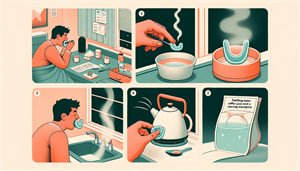Frustrated with your snoring mouthpiece? Proper adjustment is key. In this guide, we’ll show you how to adjust your snoring mouthpiece for maximum comfort and effectiveness. From initial fitting to fine-tuning, we cover everything you need for a quieter night.
Key Takeaways
-
Snoring mouthpieces, such as mandibular advancement devices, effectively treat snoring and sleep apnea by keeping airways open during sleep.
-
Proper fitting and adjustment of the mouthpiece through techniques like the boil and bite method are essential for comfort and effectiveness.
-
Regular maintenance and monitoring for common issues like discomfort or excess saliva are crucial for ensuring the longevity and effectiveness of the mouthpiece.
Understanding Your Snoring Mouthpiece

Snoring mouthpieces are innovative devices designed to treat sleep apnea and reduce snoring by keeping your airway open during sleep. These oral appliance come in various forms, with the most common type being the mandibular advancement device (MAD). MADs work by positioning the lower jaw slightly forward, thereby preventing the airway from collapsing and maintaining airflow. An anti snoring mouthpiece is particularly effective for this purpose, and dental sleep medicine plays a crucial role in their development.
There are also tongue-stabilizing devices (TSDs), which use suction to hold the tongue in place, making them a good alternative if MADs are not suitable for you. Some mouthpieces are designed to be worn on the bottom teeth, while others fit the upper teeth or are made with thinner materials to enhance comfort.
Using a snoring mouthpiece can significantly improve your sleep quality and help you stop snoring, making you feel more refreshed and energetic upon waking.
Initial Fitting Process

The initial fitting process is key to making sure your snoring mouthpiece fits properly and delivers the desired benefits. The most common method for fitting these devices is the boil and bite technique, which involves heating the mouthpiece in hot water and then molding it to your teeth. This method helps create a secure fit and custom impression suited to your dental structure.
Adjusting the lower jaw forward is an important step. This helps keep the airway open by positioning the lower jaw slightly forward. Carefully follow the fitting instructions to avoid biting too hard on the gutters or forcing jaw movements.
Boil and Bite Method
The boil and bite method is a popular and effective way to fit your snoring mouthpiece. Start by dipping the mouthpiece in hot water for about 12 seconds to soften the material. Once softened, place the mouthpiece in your mouth and bite down gently to mold it to your teeth, ensuring it creates a secure fit.
This technique allows you to create a custom impression of your teeth, which is crucial for the mouthpiece’s success in reducing snoring. Follow the fitting instructions closely to ensure comfort and effectiveness.
Adjusting Lower Jaw Forward
Adjusting the lower jaw slightly forward during the fitting process helps prevent the airway from collapsing and ensures continuous airflow.
During the fitting, move your lower jaw into a comfortable forward position without biting down too hard on the mouthpiece’s gutters. This step is essential for achieving the desired results and maintaining comfort to ensure that the mouthpiece will fit properly.
Fine-Tuning for Comfort
Once your snoring mouthpiece is fitted, fine-tuning it for comfort is necessary. Initially, you might experience some discomfort or tightness, which usually alleviates over time with proper adjustments. Small adjustments can significantly enhance comfort and effectiveness.
Fine-tuning involves reshaping the mouthpiece, ensuring a proper fit, and regularly checking its position. This process reduces discomfort and ensures a secure fit for effective use throughout the night.
Using Fingers and Tongue
Using your fingers and tongue can help shape the mouthpiece for a more secure and comfortable fit. Gently press the mouthpiece with your fingers while using your tongue to mold it, especially around the edges.
This method ensures the mouthpiece conforms to the unique shape of your mouth, providing a snug fit that can significantly reduce discomfort.
Cooling and Rechecking Fit
After molding the mouthpiece, cooling it in cold water helps solidify its shape and improve the fit. Once cooled, recheck to ensure it sits securely against your upper teeth without needing assistance from your tongue.
This step is crucial for ensuring that the mouthpiece maintains its position comfortably throughout the night, providing consistent benefits while you sleep.
Common Issues and Solutions
Even with a well-fitted mouthpiece, you might encounter issues like pain, discomfort, or excess saliva. Address these issues promptly to ensure continued use and effectiveness.
Understanding potential problems and knowing how to solve them can improve your experience with the mouthpiece. Adjusting the fit can reduce discomfort, and gradually getting used to the device can help overcome initial resistance.
Addressing Pain and Discomfort
Some users may experience soreness in their jaw or teeth as they get used to wearing the mouthpiece. This discomfort is often temporary and can be alleviated by making small adjustments to the fit or by gradually increasing the time you wear the mouthpiece each night.
If pain or discomfort persists, consult your dentist for adjustments. They can ensure the mouthpiece fits correctly and does not cause long-term issues.
Preventing Excess Saliva
Some users might find that wearing a snoring mouthpiece increases saliva production. This issue is usually temporary and can be managed by adjusting the fit or using it consistently until your body adapts.
A snugly fitting mouthpiece that does not move around can reduce the sensation of excess saliva, making it more comfortable to wear throughout the night.
Maintaining Your Snoring Mouthpiece

Proper maintenance of your snoring mouthpiece is vital for its longevity and effectiveness. Regularly rinsing with warm water after each use maintains hygiene and prevents the buildup of plaque and bacteria.
Soaking the mouthpiece in a denture cleaner or using dental cleaning tablets can keep it clean and odor-free. Always store the mouthpiece in a dry, well-ventilated area to prevent mold growth and ensure it remains in good condition.
When to Consult a Dentist
While many snoring mouthpiece issues can be resolved at home, sometimes consulting a dentist is necessary. If you experience persistent jaw pain or discomfort, seek professional help to adjust the mouthpiece and ensure it fits correctly.
Proactive consultation with a dentist can prevent serious issues like teeth shifting or jaw misalignment, ensuring the mouthpiece functions properly and provides the intended benefits.
Summary
In summary, a well-fitted snoring mouthpiece can significantly improve sleep quality by reducing snoring and treating sleep apnea. Following the proper fitting process, fine-tuning for comfort, and addressing common issues are key to ensuring the device works effectively.
Remember, consistent use and proper maintenance of the mouthpiece are crucial for its longevity and effectiveness. If you encounter persistent issues, don’t hesitate to consult a dentist for professional advice. By following these guidelines, you can enjoy peaceful, uninterrupted sleep and wake up feeling refreshed and energized.
Frequently Asked Questions
How do I know if my snoring mouthpiece fits properly?
A properly fitted mouthpiece should feel snug without causing pain or discomfort. Using the boil and bite method can assist in achieving a secure fit.
What should I do if my mouthpiece causes pain or discomfort?
If your mouthpiece causes pain or discomfort, it is essential to consult your dentist for adjustments to ensure a proper fit. Persisting discomfort should not be ignored, as it may lead to long-term issues.
How can I prevent excess saliva while using the mouthpiece?
To prevent excess saliva while using a mouthpiece, ensure it fits snugly to minimize movement, which can help reduce saliva production. Consistent use will allow your body to adapt more effectively over time.
How do I maintain and clean my snoring mouthpiece?
To maintain and clean your snoring mouthpiece, rinse it with warm water after each use and soak it in a denture cleaner or dental cleaning tablets regularly. Ensure it is stored in a dry, well-ventilated area to prevent mold growth.
When should I consult a dentist about my snoring mouthpiece?
You should consult a dentist about your snoring mouthpiece if you experience persistent jaw pain, discomfort, or notice any shifting of teeth or jaw misalignment. It is essential to address these issues promptly to prevent further complications.


